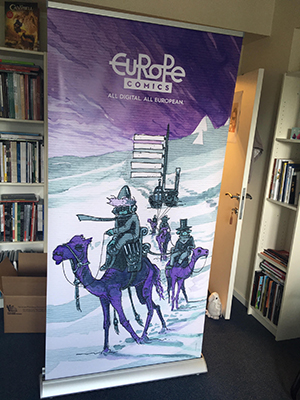NYCC 2018 interview
September 29, 2018
 From Oct. 4th – 7th the Europe Comics team will be traveling stateside for the 2018 New York Comic Con, and we have the privilege of bringing with us Polish author Mateusz Skutnik, creator of the groundbreaking series Revolutions, in addition to his popular computer games. Be sure to stop by our booth #1558 for one of his signing sessions, and don’t miss his panel discussion on Fri. Oct. 5th, on “The World Comics Invasion.”
From Oct. 4th – 7th the Europe Comics team will be traveling stateside for the 2018 New York Comic Con, and we have the privilege of bringing with us Polish author Mateusz Skutnik, creator of the groundbreaking series Revolutions, in addition to his popular computer games. Be sure to stop by our booth #1558 for one of his signing sessions, and don’t miss his panel discussion on Fri. Oct. 5th, on “The World Comics Invasion.”
How did you decide to become a graphic novel artist? How did you achieve this goal?
Actually, I remember it clearly. It was early autumn of 1986, I was 10 years old, and as I held one of our Polish comic books for kids, I thought to myself, “This seems easy enough, I can do that too.” My grandma bought me a blank notebook that day and I immediately started drawing adventures of He-Man. Of course things weren’t so easy as they seemed, it took me about 10 years before my drawings became half-decent. I’m trying to improve to this day.
How would you describe the comics scene in Poland? How has it changed since you started creating graphic novels?
You’re asking me about the last quarter of a century of comic book history in Poland… Long story short: when I was starting in the late nineties the situation was abysmal, especially for Polish creators. We had our share of legendary comic book writers, we had our Marvel and DC comics on newsstands, but that was basically it. Me and most of my fellow comic book creators around my age were creating straight into the abyss, with no chance of publication on the horizon. And now? The market is flourishing, getting bigger from year to year, there are lots of great authors from what I’d consider the next generation after me. And hey, they even respect us, those aging guys from the “bygone era of sorrow.” Things are looking good.
Which other comics artists and writers inspire you? Who would you like to collaborate with, in Europe or beyond?
Nicolas de Crécy is one. I’m just in constant awe of this guy’s audacity and style. In a way he set me free. After reading his books I felt good about creating flawed, unapologetic drawings for my own books.
Tove Jansson comes to mind. She must have been the earliest inspiration for my non-realistic, yet atmospheric style of drawing. She also wrote a piece about the Snufkin creative process (Snufkin being a character from her series The Moomins), which became a template for my entire writing career.
Of course, Grzegorz Rosinski. He is a legend in our Polish comic book world. Everybody wanted to be like him, to have a career like his, a career that happened once and would never happen again. Also, Thorgal was a pretty good series to have grown up with. I’m buying and reading it still, to this day.
Finally, Hugo Pratt — a self-explanatory choice. He’s a legend worldwide, the Corto Maltese books are classic, and his watercolors are on an even higher level. Sometimes I just like to look at what he created to remind myself of how insignificant I actually am. That’s a very healthy thing to do, you know.
Tell us a bit about your series Revolutions, and the creative process behind it. How would you describe the genre? Which elements of these books did you find the most fascinating or challenging?
Here’s the elevator pitch: Revolutions is a series about the technological revolution of the late 19th, early 20th century. For every genius invention of that era there were probably 10 or more insane ones that never made it, forever lost to oblivion. This series is about those inventions and the people behind them. I’m striving to create a new comic book album each year, and it’s mostly this series. I want to give people the certainty of a series. That’s why, while we’re on book 11 right now, I have four more books lined up for the coming years. They’re almost written, too. By that I mean I have about 70% of the structure of each of those books set, they just need polish. This queue of books allows me to dodge the dreadful situation of sitting over a blank page not knowing what to do. I hate that. I’m unable to write when pressured to do so. The most fascinating thing about creating a comic is the transition between the spoken word and a panel of drawings. That’s the moment when the comic book magic happens. Writing a story, drawing it — sure, those are the meat of it, but most fascinating is the transition between.
What projects are you currently working on?
Right now I’m working on my biggest computer game yet. It will be the outcome of 10 years of experience in creating games such as Submachine and Daymare Town, combined with my comic book style of storytelling and watercolor graphics. It’s my most ambitious project to date. As for comic books I’m writing next chapter of the Blaki series, which will probably be published next year, and after that another Revolutions trilogy.







